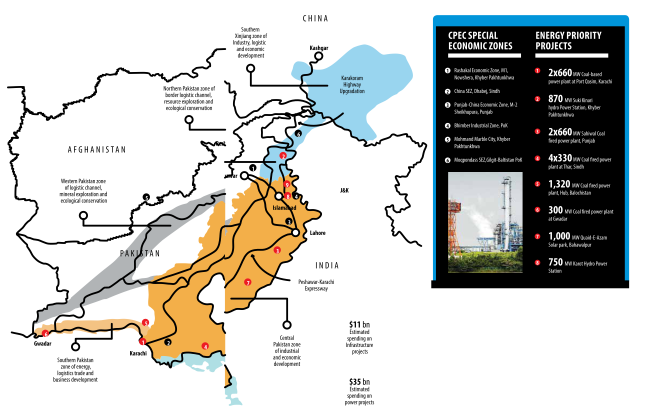[vc_row][vc_column][vc_column_text]
The China-Pakistan Economic Corridor that has the Gwadar Port at its epicentre aims to transform the infrastructure in Pakistan, right from power to logistics
China and Pakistan have been long-term allies with bilateral trade witnessing threefold increase in the past few years, to $13.7 billion in 2015-16, up from just $4 billion in 2007. Today, China accounts for 40 per cent of Pakistan’s foreign direct investment, which is only around $2 billion. A $600 million investment by China in 2015-16 contributed to a 38 per cent rise in FDI in Pakistan.
A major Chinese initiative with Pakistan is the China-Pakistan Economic Corridor (CPEC) agreement that will help Pakistan improve its logistics infrastructure and place the country at the centre of the new Silk route. With a total outlay in excess of $62 billion, CPEC is a key pillar of China’s One Belt, One Road (OBOR) programme. CPEC is approximately a 3,000-kilometre network of roads, pipelines and railways to transport goods from Gwadar Port in Pakistan to Kashgar in the Xinjiang Uygur Autonomous Region of China. The $52 billion project intends to rapidly modernise Pakistan’s infrastructure, improve energy ecosystem and establish special economic zones.
$35 billion worth of energy projects under CPEC span across renewable energy, coal and LNG. This will help solve Pakistan’s existing energy shortfall of around 4,000MW. $11 billion investment will go in developing highways and transport networks. By cutting a corridor directly from Kashgar to Gwadar can result in accessing $6.5 billion per annum of Chinese spending on shipping of oil from the Middle East currently done via the Strait of Malacca. Thus, such opportunities present Pakistan as a major logistic hub on the global map.
Under CPEC, Chinese companies will grow crops, build meat processing plants and develop free trade zones in Pakistan. Chinese garment factories will, en masse, be transferred to Pakistan, while China will manage and run tourism projects and SEZs along the southern coast, with rather ambitious plans for even yacht clubs and hot spring hotels to develop an unlikely tourism hub in the restive Balochistan province.
Around 6,500 acres will be leased to China for agricultural demonstration projects. China has announced 17 projects with a total investment of $35 billion. These include a fertiliser plant with an annual 800,000 tonne output, Vegetable and grain processing plants with a 1 million tonne capacity and a coal-powered plant at Sahiwal in the Punjab that is already functioning.
In addition to this, the Chinese are planning to overhaul Pakistan’s road and rail infrastructure, starting with upgrading sections of the Karachi-Peshawar road and rail line. The Karakoram highway will be upgraded to serve as a key arterial link connecting Xinjiang and Gwadar. it is already being used to ship goods transported from Xinjiang to West Asia.
Chinese companies in collaboration with Pakistani counterparts will build a three-level warehousing system (purchase and storage warehouse, transit warehouse and port warehouse). A national storage network of warehouses will be constructed, starting in Islamabad and Gwadar and then in Karachi, Lahore and Peshawar.
A cotton processing plant with a 100,000 tonne output has been planned and in the future China may shift its garment industries directly to Pakistan to leverage on the lower wages, availability of land, and export tariffs in Pakistan. China is also planning to develop Pakistan’s mineral resources, particularly in Balochistan and Khyber-Pakhtunkhwa, eyeing gold reserves as well as setting up marble and granite processing sites.
China sees the Gwadar Port as the heart of the CPEC and envisages a free trade zone and a manufacturing hub there to serve as a launch pad for exports to West Asia and Africa. China has already secured a 23-year tax-free deal for its companies that will operate out of Gwadar. An ambitious annual cargo throughput of 300-400 million tonnes from the port is forecast when the project is through, which will be 10 times more than Pakistan’s current biggest port in Karachi.
[/vc_column_text][/vc_column][/vc_row]







